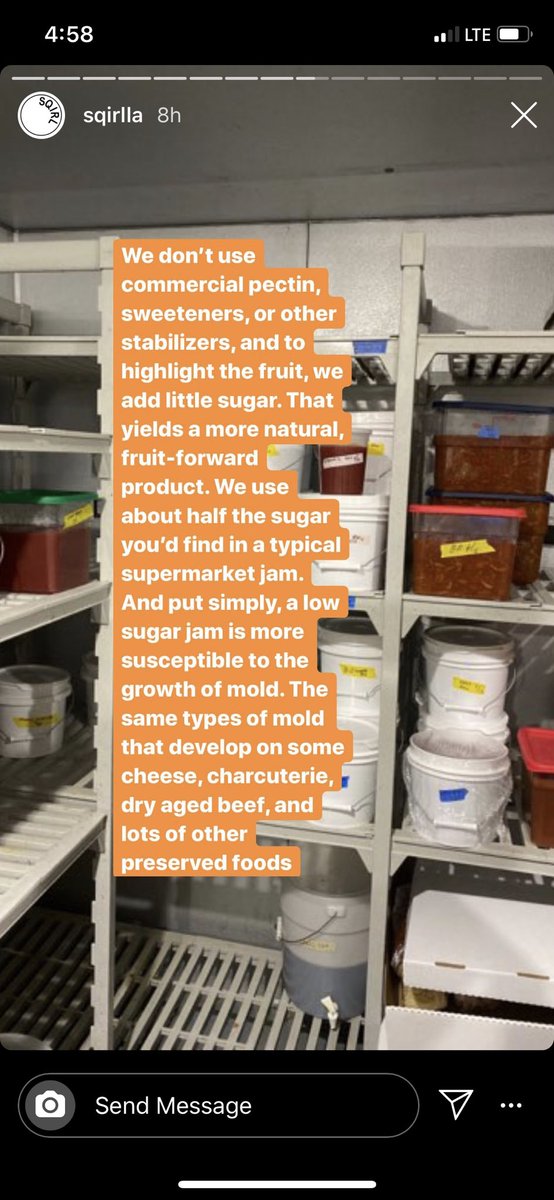hi! master food preserver here! (serious, i have the pretty papers from Cornell and CA!) while looking over the claims being made about a certain CA jam company, a few points to be made about: hot oven pack, low-sugar jams, and mold.
1) USDA frowns upon the method of hot oven pack for sealing, preferring hot water bath for all canning purposes. the reason for this isn’t about sterility per se, but sealing specifically: the fail rate for hot oven pack can be as high as 25%, if proper conditions aren’t met.
continuous thread retort lids, like the ones being used broadly in retail, unlike lug/twist screw lids (ie mason jars) utilize a plastisol heat seal, but are not typically meant for a hot water pack. they require high heat/pressure sealing via induction. they are generally safe.
(provided they follow those more intense conditions.
they are also cheaper by a mile, per unit, for 6-8oz retail sized jams by a matter of .75-1.00/unit.)
they are also cheaper by a mile, per unit, for 6-8oz retail sized jams by a matter of .75-1.00/unit.)
2) low sugar jams are broadly defined as jams with 50% or less sugar to weight of fruit (some states and federal definitions differ but not substantially). Their a rise in popularity: from those considering the brix rate of the fruit itself, and consideration of diabetics/diet.
many commercial jams from small scale producers fit the first mold; selecting specific fruits by cultivar and cultivation style (say, water restricted stone fruit) would yield jams toothachingly sweet if traditional proportions (70% sugar to fruit weight, avg) and obscure flavor.
USDA regs presume a consistent sugar content for most fruit types: blackberries will have x sugar per lb dry weight, strawberries y sugar per lb dry weight. that may be true in commodity fruit, it is less likely to hold for specialized farmers, or adjusting for seasonal variation
low sugar jams at the 40-50% range can still hold for preservation quality, depends on recipe. many makers dont use commercial pectin; they usually require an external acid (lemon juice, ex) to assist in coaxing natural pectins. that acidulation also helps in preservation quality
if the recipes published by the company in question are true to the recipes as executed, most would hold in a preservation; spontaneous spoilage is unlikely unless, say, opened and then left on a counter instead of a fridge. what this doesn’t control for: external mold vectors.
3) the big issue from initial reporting indicates bulk jams were held in a walk in with a faulty hvac/fan system, with molds present in the filter. this led to the presence of extensive molds on the surface of bulk jams forming. this could happen to jams of any recipe format.
there is a photo around of one such jam in an open cambro; its both pretty extensive and gross. depending on temperature in walk-in, it would take some time (if cooler) to no time (if intemperate) for that degree of mold to form; 24 hours would be sufficient for an initial layer
(it would also require a high-degree of inattentiveness; that jam would have to sit uninterrupted for days to achieve that degree of penetration.)
mold can happen, and pretty universally, whether for home or commerical use, within nearly all communities and perspectives, the answer is the same: jam must be assumed contaminated (unseen spores, release of toxins, secretions into the mix) at all levels, and destroyed.
which is why this frame of their explanation annoys and disturbs me: the final line is simply not fundamentally true.
the types of molds found on/in cheeses, meats, other preserved foods is fundamentally untrue. the different structural character of those products, the molds...
the types of molds found on/in cheeses, meats, other preserved foods is fundamentally untrue. the different structural character of those products, the molds...
in question are of different classes. most of those in cheese or dry aged meats are benign, or removed before consumption (dry aging) most of those products are firm with little hydrolysis; fruits and jams are fundamentally different in that way (as with mold on fresh cheeses.)
as someone who believes in the value of cultivar-driven, lower sugar jams, i was annoyed with some of the info coming out from this case b/c it betrayed a lack of deep knowledge about canning and preservation debates, even as the attn it was seeking is necessary.
but in seeing the response from the company in their practices and as indicated, im quietly furious because the ownership should know better. jessica was in the first MFP cohort in LA. and while we agree the USDA info is conservative, the food safety angle is not up for debate.
(and until I see an address for their commercial canning operation seperate from the place in question, I’d likely believe the claims of staff about production/fulfillment. id also want to see their batch/recipe/schedule process to assess recipe adherence to safety protocols).
Shit like this is a black eye to broader small food production community, hinders better support for non-commercial canning products and better regulations for small-scale producers. I understand wanting to cut some regulatory corners like schedule processing! but this ain’t it.
we also shouldn’t accept there’s only one way to do shit; there are many acceptable methods of preservation, provided youre paying attention to the details, and especially if doing sales, erring on the side of public health. dont just accept the claim “their process was wrong”!
some major questions that arise: why were bulk jams being cooled before packing into jars, which would defeat any hot pack methodology (and yield the issue of spontaneous mold in retail jars if the holding environment were compromised)? were jams held in this way for retail pack?

 Read on Twitter
Read on Twitter


